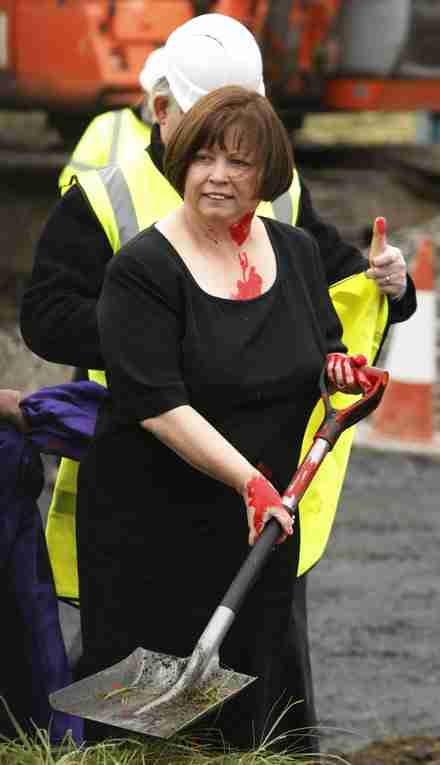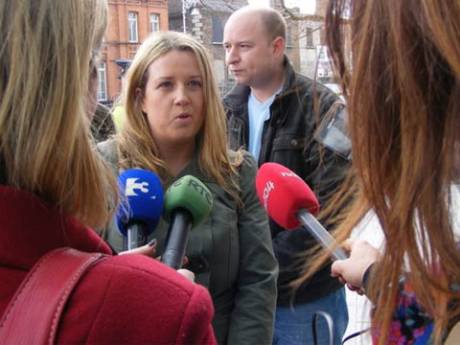Minihan Convicted of Harney Assault
 dublin |
rights, freedoms and repression |
news report
dublin |
rights, freedoms and repression |
news report  Monday February 28, 2011 10:12
Monday February 28, 2011 10:12 by éirígí PRO - éirígí
by éirígí PRO - éirígí
éirígí Dublin City Councillor Louise Minihan was handed a two month suspended sentence and a €1,500 fine on Friday last [February 25] following her convictions on charges of assault and of causing criminal damage. The convictions arose from a high-profile protest against the under-funding of the health service which took place on November 1, 2010. As part of that protest Louise poured diluted red paint over the clothing of the then Twenty-Six County Minister for Health Mary Harney at Cherry Orchard Hospital in Dublin.
Justice – Twenty-Six County Style
Those who attended the packed courtroom in the Criminal Courts of Justice on Friday were treated to a textbook case of Twenty Six County style justice. Before the presiding judge, Anne Watkins, had even entered the court it was clear that the state was intent on sending a message to those who might dare to challenge the might of the ruling class. Mingling amongst the many that came along to support Louise were at least seven plainclothes Gardaí. And just to make sure that everyone got the message they were joined by at least fifteen uniformed Gardaí who sat in the courtroom through an entire morning of non-related cases. Such blatant intimidation is, of course, the stock and trade of a police force that is more interested in crushing political dissent than catching criminal bankers, politicians and developers.
When Louise’s case was finally heard it was Mary Harney who first took the witness stand. In recounting her recollection of the disrupted sod-turning ceremony Harney told the court that she recalled hearing Louise say ‘you have blood on your hands’ as she poured the red paint onto her shoulder. Yet minutes later, when under cross examination from the defence, Harney ridiculously claimed she had no idea what might have motivated Louise’s actions. This reluctance to concede the political and non-criminal nature of the alleged assault did not, however, prevent Harney from stating that Louise’s actions were ‘not an acceptable form of protest.’
Four Weeks Dole for a Coat
During the course of her testimony Harney estimated the value of the coat and dress which had allegedly been destroyed by the red paint at ‘six hundred to eight hundred euro’ - the equivalent of more than four weeks dole in the Twenty Six Counties. While the nonchalant revelation of Harney’s expensive taste was met with wry laughs from many in court, it could not have come as a surprise. This is, after all, a minister who famously spent $410 of taxpayers’ money getting her hair washed and blow dried while on a junket in Florida.
The next witness in the box, a Garda Sergeant Simon Murphy from Ballyfermot Garda Station, told the court that he had observed Louise ‘throw’ paint at Harney. From a distance of thirty feet his clearly excellent vision allowed him to see into the middle of the assembled crowd to observe Louise ‘squeezing’ a bottle from which red paint had emerged. So good was Murphy’s eyesight he even saw exactly how the liquid was dispensed, which he helpfully mimicked by moving his hand in an upward motion, implying that the paint had been sprayed or propelled upwards onto Harney.
When asked, however, exactly where Louise had been detained Murphy’s excellent powers of recall seemed to suffer a bit of a setback. When it was put to him that Louise had not been arrested beside Harney but had in fact walked more than thirty feet to a pedestrian exit from the building site, Garda Murphy appeared to become a little confused, but eventually stuck to his written witness statement that Louise had been arrested by a Garda Casserly ‘immediately’. This confusion over the location of Louise’s arrest might have been understandable had Murphy not claimed that he himself was standing beside the very same pedestrian exit that Louise had in fact walked to following her protest.
Great Eyesight – Poor Memory
Next up in the witness box was a Garda Gemma Casserly, also from Ballyfermot Garda station. Like Garda Murphy, Casserly appeared to be suffering from a rare medical condition consisting of excellent eyesight combined with a form of schizophrenic recall. Certain details she remembered very clearly but other details seemed to have been lost in a fog of confusion and potential bewilderment.
While Garda Casserly got off to a bad start with her evidence by referring to the ‘blood’ on Harney’s neck, she made a good recovery and stuck to her story regardless of the glaring holes that it contained. Like Murphy, eagle-eyed Casserly observed the paint protest from a distance of thirty feet. Her re-enactment of the alleged upward dispensing of the paint was strangely familiar, indeed it was almost identical that of her colleague some minutes beforehand.
And Casserly had brought dramatic evidence to court to back up her version of events. From deep inside a padded brown envelope she withdrew the smoking gun - a dark coloured water bottle of the type used by cyclists and sporting enthusiasts the world over. This, the court was told, was the very bottle which had been used to deliver the red paint to the Minister for Death. When pushed on what exactly she had seen, Casserly said she had seen Louise ‘spray paint’ at Harney from the bottle.
When it was put to Casserly that a Garda Steven Monaghan had, in his written witness statement, stated that she and he were outside of the building site forming a ‘barrier’ to prevent protesters from entering the site, she denied that this was the case. When asked exactly where she had arrested Louise Casserly’s memory only allowed her to say that she was ‘arrested where the sod turning was taken place’, without being able to specify if the arrest had taken place beside Harney or beside the pedestrian entrance thirty foot away. When it was put to Casserly by the defence that she was ‘glossing’ her evidence, her denial was about as convincing as the rest of her contribution.
The fourth and fifth state witness’s were Concepta De Brún and Jim Curran respectively, both employees of the Health Service Executive and both standing within about ten foot of Louise and Harney at the time the paint was poured. In her testimony De Brún stated that Louise had poured the paint ‘all in one go’ and that Louise then ‘walked past her’ in the direction of the pedestrian entrance. De Brún also told the court that she had seen Louise ‘twist’ the lid of the bottle prior to pouring of the paint. For his part Curran stated that Louise had ‘emptied’ the paint on Harney before she had ‘moved to the exit.’ In their evidence both witnesses indicated that the paint had been poured out of the container in a downward direction.
Legitimate Political Protest
With no further prosecution witnesses to be called the prosecution case against Louise was completed. The defence solicitor then explained that Louise was not contesting the broad sequence of events, notwithstanding elements of the Garda evidence. Louise fully accepted that she poured the paint on Harney as part of a political protest but rejected the assertion that this constituted an assault. The defence went on to explain that Louise did not believe she had done anything wrong and was therefore not willing to plead guilty.
Throughout the trial Judge Watkins made plain her annoyance at the fact that Louise was unwilling to plead guilty. This was a theme that she continued as she delivered her findings, attempting to berate Louise for ‘wasting taxpayers’ money’ whilst making no comment on the fact that it was the state that had initiated proceedings in a case that should have never been brought before the courts. Needless to say she didn’t have anything to say about the taxpayer’s money that was being wasted in front of her very eyes by the more than twenty Gardaí that had spent the best part of the day trying to intimidate Louise and her supporters.
For Watkins the idea that a young woman could take a principled stand and be willing to go to jail as a result of that stand was unthinkable. Her assertion that Louise was ‘misguided’ smacked of an authority figure desperately seeking alternatives to the possibility that their authority was being directly challenged.
Authority Faced Down
As she moved to sentencing Watkins was in for another rude awakening with regard to the strength of her authority. During her testimony Harney had indicated that she was unwilling to accept a compensation payment from Louise, which prompted Watkins to ask if Louise was willing to make a donation to a charity of Harney’s choosing by way of compensation. Following a brief consultation Louise’s solicitor informed the court that she was willing to make a charitable donation to Cherry Orchard Hospital, but not to a charity of Harney’s choosing.
Watkins growing incredulity and frustration could not be hidden behind the facade of judicial authority. Judges expect the guilty to be suitably contrite, not consistently defiant. Without plan A, the charitable donation, available to her, Watkins moved to plan B, a two month jail sentence, suspended for one year, for the criminal damage and community service for the assault. But before she could give the details of the community service she was interrupted by the defence who informed her that Louise was unwilling to co-operate with community service. Time for plan C, which involved Watkins asking the state prosecutor what the maximum fine for assault was. A quick check of the relevant legal tome and Watkins imposed a €1,500 fine. When informed by the defence that Louise would not be paying the fine Watkins had no plan D to fall back on. Instead she informed the court that it was Louise’s business whether she paid it or not. And with that the case was closed.
Harney in the Dock
For many of those who sat through Friday’s proceedings there was some small sense of satisfaction in seeing Mary Harney appear in a court. It may have been petty but it felt good to see Mary Harney’s day ruined, to see her inconvenienced for a few hours, for her to have to sit in court and answer a few questions. It would have been far more satisfying to see her a few feet to the left, in the accused dock instead of the witness box. And it would have been more satisfying yet to have seen her cross examined for hours about her failure to protect those who had been entrusted into her care as Minister for Health; to have seen her grilled by a prosecution about how she feels about the tens of thousands of people who have suffered and died as a result of her blind adherence to a neo-liberal ideology; to have seen her confronted by the families of her victims, those who have needlessly died over the term of her ministry.
The Fourth Estate – Defenders of Democracy
The ‘blood on your hands’ protest and the subsequent court case revealed many things about the nature of the Twenty-Six County state. When Louise disrupted Harney’s photo opportunity last November the state and private media went into overdrive attacking Louise and éirígí. The ‘fourth estate’ wasted no time in jumping to the defence of Harney and the wider political establishment. This was best exemplified by the Joe Duffy show which broadcast on the afternoon of the protest. The presenter disgraced himself, dedicating his entire show to what amounted to a witch-hunt against Louise. The print media weren’t far behind, attempting to dig up dirt on Louise and her family within hours of the protest.
The constant bleat of these pseudo-journalists has been that actions like the ‘blood on your hands’ protest are ‘anti-democratic’ and ‘unacceptable’. The ‘democracy’ advocated by these self-appointed and well paid guardians of democracy is of a type that sees the people politely queuing at the polling booths once every five years before quietly returning to their homes. No matter if they can’t afford to pay for those homes, or heat those homes, no matter if inside of those homes their children lie awake with the cold and the hunger. Under no circumstances must you do anything but vote.
This is the ‘democracy’ of Tony O’Reilly and Denis O’Brien, where media barons can control vast swathes of the print and broadcast media whilst living as tax exiles. The type of ‘democracy’ where nothing but the most useless and sterile forms of political activism are tolerated. In their ‘democracy’ you can vote for a wide variety of identical political parties, you can write an angry letter to the Irish Times and you can ring Joe Duffy if you want. But under no circumstances can you do something effective. No general strikes, no rent strikes, no mortgage strikes, no occupations, no mass protests, no civil disobedience, no direct actions and under no circumstances must you pour red diluted paint on the coat of a member of the ruling class.
Political Policing
Political activists sometimes need to take a step back and examine what they consider to be ‘normal’. In the court on Friday last a large force of undercover and plain clothes Gardaí were deployed for the sole purpose of intimidating and isolating those who had come along to show their support for Louise. This type of behaviour by the Garda may be commonplace but that does not make it right.
And Garda conduct in the witness box is no better. Every day of every week members of the Garda get into witness boxes and tell the most outrageous, bare faced lies. Political activists know it, solicitors know it, journalists know it, politicians know it but nobody does anything about it. It’s just the way of things in the Twenty-Six Counties.
The evidence given by both HSE employees was significantly different to that given by the two Garda witnesses, specifically in relation to how the paint was dispensed and what happened directly afterwards. Murphy statement of witnessing the bottle being ‘squeezed’ from a distance of thirty foot away was laughable. Similarly Casserly’s claim of paint being sprayed does not fit with the evidence supplied by the two HSE employees who were far closer to the scene.
No less than eighteen witnesses who were within the immediate vicinity of the sod-turning ceremony at the time the paint was poured have provided written statements stating that did not see what happened. Witnesses who were within a couple of paces of Harney have stated that they didn’t see what had happened until the crowd ‘separated’. In fact only those who were directly beside Harney and Louise, such as De Brún and Curran were able to give accurate descriptions of what actually happened. And of course the two Gardaí with fighter pilot vision who were located thirty foot away. The same two Gardaí who claim they left a third Garda outside on his own to ‘from a barrier’ to stop fifteen ‘loud’, ‘abusive’ and ‘vulgar’ protesters from entering the site.
It is a fact that Louise unscrewed the entire top of the water bottle and poured the paint onto Harney’s shoulder. It is simply not possible to ‘spray’ paint from a two inch wide opening. The only way it could have been sprayed would have been if main lid had been in place, the narrow drinking nozzle lifted into the open position and the body of the bottle squeezed. It should be noted that Louise screwed the lid of the water bottle back in place as she walked away from Harney, before she was taken into custody, which meant that the Gardaí recovered it in that state.
The Garda witness’s version of what happened after the protest is also at odds to that provided by others present. Eight witnesses provided written statements stating that they saw Louise walking ‘towards’ the exit or stating that they saw Louise make her way to the exit, the same exit the both Murphy and Casserly were allegedly standing at. And yet neither of the two could categorically state if Louise had walked away from Harney or where Louise was arrested. Strange that.
With regard to the outcome of the case the evidence of the Garda was not of crucial importance. Louise has never denied that she poured the paint on Harney’s clothing. But it is indicative of the modus operandi of a force where lying has become so habitual it is done even when a defendant isn’t disputing the facts.
Join the Fight-Back
Over the last four months the corporate media, the Garda and the judiciary have all played their respective roles in responding to a lone protester pouring some paint on the Minister for Death. Each has played their part in discouraging others from following the example of the ‘blood on your hands’ protest. Not because they fear a rash of red paint attacks but because they fear that it might herald a qualitative escalation in the form of political protest in the Twenty Six Counties.
For a few short minutes the ‘blood on your hands’ protest ruptured the cocoon that the political class live within. For once someone who was directly responsible for visiting unnecessary terror, fear, suffering and death on others was momentarily held to account. And the reaction of the state shows just how much they fear protests which do not play within the rules laid down by the state.
By mid March a Fine Gael led government will be in place in Leinster House and it will be back to business as usual for the ruling class. And as it becomes apparent that this ‘new’ government is indistinguishable from the ‘old’ government the people of the Twenty Six Counties are going to have to look beyond elections and sound-byte politicians for real solutions. They are going to have to look to ‘unacceptable’ forms of protest which they themselves are going to have to organise and participate in.
The future of the Twenty-Six Counties and of Ireland does not rest in Enda Kenny’s hands, it rests in the hands of each and every citizen, each of whom has the right to a better future than the one the EU and IMF have in store for them. The fight back is already underway and it will gather pace as Fine Gael sets about extracting the price of the EU/IMF bailout. And ‘unacceptable’ actions like Louise Minihan’s will have to be central to that fight back if it is to be successful.



